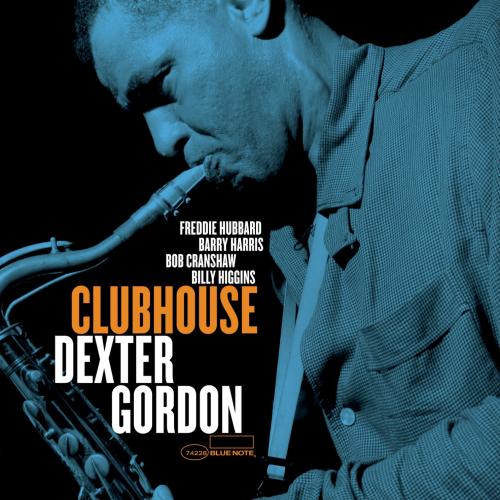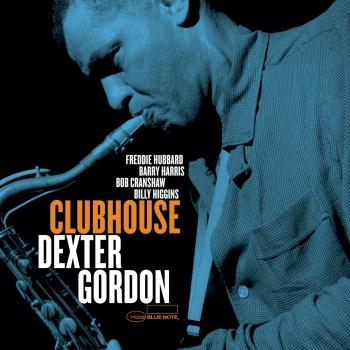
Clubhouse (Remastered) Dexter Gordon
Album Info
Album Veröffentlichung:
1965
HRA-Veröffentlichung:
13.09.2019
Das Album enthält Albumcover
Entschuldigen Sie bitte!
Sehr geehrter HIGHRESAUDIO Besucher,
leider kann das Album zurzeit aufgrund von Länder- und Lizenzbeschränkungen nicht gekauft werden oder uns liegt der offizielle Veröffentlichungstermin für Ihr Land noch nicht vor. Wir aktualisieren unsere Veröffentlichungstermine ein- bis zweimal die Woche. Bitte schauen Sie ab und zu mal wieder rein.
Wir empfehlen Ihnen das Album auf Ihre Merkliste zu setzen.
Wir bedanken uns für Ihr Verständnis und Ihre Geduld.
Ihr, HIGHRESAUDIO
- 1 Hanky Panky 06:32
- 2 I'm A Fool To Want You 06:43
- 3 Devilette 07:05
- 4 Clubhouse 07:33
- 5 Lady Iris B. 05:41
- 6 Jodi 05:40
Info zu Clubhouse (Remastered)
One of the enduring mysteries of Blue Note history is that superb sessions such as Dexter Gordon’s Clubhouse (recorded in 1965) remained unreleased in the vault until the late 1970s. Recorded during the middle of Gordon’s “golden period” career renaissance after he signed with Blue Note in 1961, the tenor saxophone legend is joined by Freddie Hubbard on trumpet and the remarkable rhythm section of Barry Harris on piano, Bob Cranshaw on bass, and the great Billy Higgins on drums. Long Tall Dexter’s rendition of the Sinatra evergreen “I’m a Fool To Want You” stands as one of his all-time greatest ballad performances.
Dexter Gordon, tenor saxophone
Freddie Hubbard, trumpet
Barry Harris, piano
Bob Cranshaw, bass (tracks 1, 2 & 4-6)
Ben Tucker, bass (track 3)
Billy Higgins, drums
Produced by Alfred Lion
Digitally remastered
Dexter Gordon
is considered to be the first musician to translate the language of Bebop to the tenor saxophone.
Dexter Keith Gordon was born on February 27, 1923 in Los Angeles, California. His father, Dr. Frank Gordon, was one of the first African American doctors in Los Angeles who arrived in 1918 after graduating from Howard Medical School in Washington, D.C. Among his patients were Duke Ellington and Lionel Hampton. Dexter’s mother, Gwendolyn Baker, was the daughter of Captain Edward Baker, one of the five African American Medal of Honor recipients in the Spanish-American War.
Dexter began his study of music with the clarinet at age 13, then switched to the alto saxophone at 15, and finally to the tenor saxophone at 17. He studied music with Lloyd Reese and at Jefferson High School with Sam Browne. In his last year of high school, he received a call from alto saxophonist Marshall Royal asking him to join the Lionel Hampton Band. He left Los Angeles with the band, traveling down south and learning to play from fellow band members Illinois Jacquet and Joe Newman. In January 1941, the band played at the Grand Terrace in Chicago for six months and the radio broadcasts made there were Dexter’s first recordings.
It was in 1943, while in New York City with the Hampton band, that Dexter sat in at Minton’s Playhouse with Ben Webster and Lester Young. This was to be one of the most important moments in his long musical career as, as he put it, “people started to take notice.”
Back in Los Angeles in 1943, Dexter played mainly with Lee Young (Lester Young’s brother) and with Jesse Price plus a few weeks with the Fletcher Henderson Orchestra. In 1944, he worked with Louis Armstrong ‘s orchestra which was one of the highlights of his careers. Being in the company of the great trumpet master was inspiring and gave him insight into the world of music that he never forgot. It was during this period that Gordon made his first lengthy solo recordings as the leader of a quintet session with Nat “King” Cole as a sideman.
In 1944, Dexter joined the Billy Eckstine band, the source of many of the Bebop innovators of the time and many of the most prominent bandleaders in the future. He was surrounded nightly by Sarah Vaughan, Dizzy Gillespie, Fats Navarro, Sonny Stitt, Gene Ammons, Leo Parker, John Malachi, and other architects of the new music.
Dexter began to record for Savoy Records in 1945 with tunes such as Blow Mr. Dexter, Dexter’s Deck, Dexter’s Cuttin’ Out, Long Tall Dexter (none of which were named by the composer). These early recordings are examples of the development of his sound and his style which influenced many of the younger tenor players of that day, including Sonny Rollins and John Coltrane.
In 1947, Dexter recorded his historic sides for Dial Records, including “The Chase” with tenor saxophonist Wardell Gray. The two tenor “duels” became very popular at this time and Dexter commented that despite the differences in style, it was sometimes hard for him to tell where one left off and the other began. This recording was to become the biggest seller for Dial and further established Dexter as a leader and a recording artist.
In the late 40s, Dexter appeared on the famed 52nd Street in New York City with Charlie Parker, Fats Navarro, Miles Davis, Max Roach, and many of the bebop innovators of the day. The classic photo of Dexter at the Royal Roost in 1948 has become the iconic photo of the bebop musician and has been reprinted on album covers, t-shirts, posters, and print ads.
In 1960, Dexter was approached by Alfred Lion to sign with Blue Note Records. For five years, he made on session after another, and they are all considered classics. When asked which of all his recordings was his favorite, Dexter said: “I would have to say it is Go! The perfect rhythm section which made is possible for me to play whatever I wanted to play.”
The Blue Note recordings allowed him the opportunity to record with Freddie Hubbard, Bobby Hutcherson, Barry Harris, Kenny Drew, Horace Parlan, Bud Powell, and Billy Higgins. The Blue Note recordings are still available and are considered jazz classics.
A gig in 1962 at Ronnie Scott’s Club in London was a new experience for Dexter and he began to travel and work in Europe. Eventually, he settled in Copenhagen where he lived until his return to the U.S. in 1976. During that period in Europe, he traveled extensively, worked for long periods at the historic Jazzhus Montmartre and recorded for European labels as well as Prestige Records.
In 1976, Dexter enjoyed a hero’s welcome in the U.S. when he made his return engagement at Storyville in New York City with Woody Shaw, Louis Hayes, Ronnie Mathews, and Stafford James. He subsequently played the Village Vanguard, signed with Columbia Records, and was officially back in town. He organized his first working band during this period with George Cables, Rufus Reid, and Eddie Gladden. He considered this band to be his best band and he toured extensively with them and recorded Live at the Keystone (Mosaic) and Manhattan Symphonie (CBS Sony) with the group.
In 1986, Dexter moved into his new career, acting, in the motion picture Round Midnight which was directed by Bertrand Tavernier. He was nominated for an Academy Award for Best Leading Actor in 1986 for his portrayal of Dale Turner, a character based on the lives of Lester Young and Bud Powell. The music for the film won an Oscar for musical director, Herbie Hancock. The film included fellow musicians Bobby Hutcherson, Billy Higgins, Cedar Walton, Freddie Hubbard, Tony Williams, Pierre Michelot, John McLaughlin, and Wayne Shorter.
Dexter Gordon’s last major concert appearance was with the New York Philharmonic in Ellingtones, a concerto written for him by acclaimed composer David Baker and conducted by James de Priest. (Source: www.dextergordon.com)
Dexter died on April 25, 1990 in Philadelphia, Pennsylvania.
Dieses Album enthält kein Booklet








![Cover The Squirrel (feat. Art Taylor, Kenny Drew & Bo Stief) [Live at Montmartre, Copenhagen 1967] (Remastered)](https://storage.highresaudio.com/web/imgcache/b0a42f8e0e1aa0874688a294bb69a561/3jt5n3-thesquirre-master_350x350.jpg)